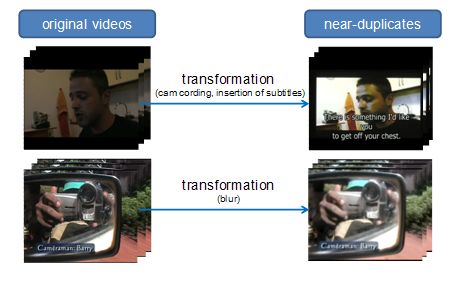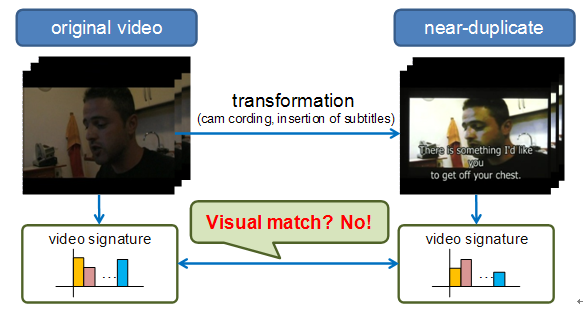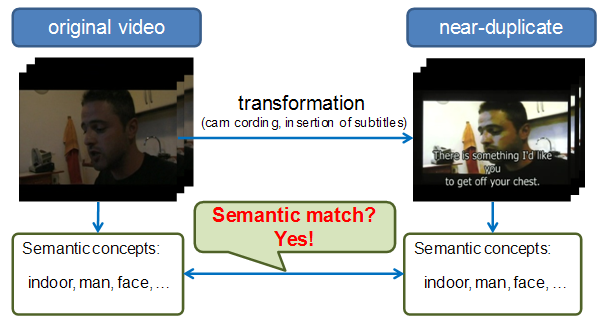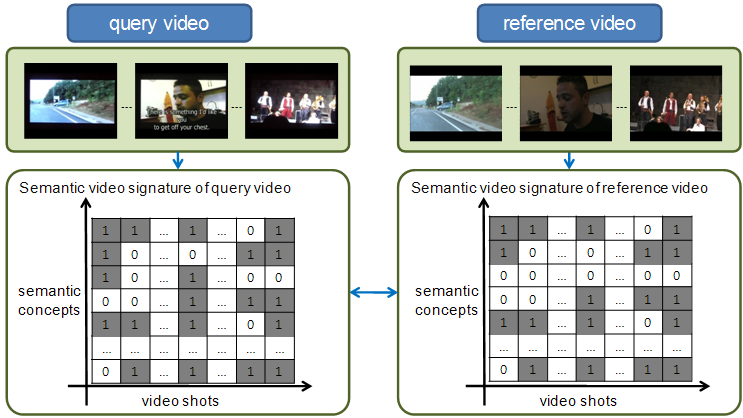|
2. Near-duplicate video
A significant amount of user-generated video content is
available on social media applications, such as ¡®YouTube¡¯ and ¡®LiveLeak¡¯.
Since digital video content can be easily edited and redistributed,
websites for video sharing commonly suffer from a high number of
duplicates (identical copies) and near-duplicates (copies that were the
subject of at least one transformation) [1]. The detection of duplicates and
near-duplicates can limit redundancy when presenting video search results
(e.g., by grouping duplicates and near-duplicates in the retrieval
results). Further, the detection of duplicates and near-duplicates is
important for the protection of intellectual property (IP).
• Near-duplicates video is approximately identical
videos
–
photometric
variations
•
e.g.,
change of color and lighting
–
editing
operations
•
e.g.,
insertion of captions, logos, and borders
–
speed
changes
•
e.g.,
e.g., addition or removal of frames
• Examples
of Near-Duplicates

Fig. 1 Examples of Near-Duplicates
3. Video signature
The performance of video copy detection techniques is
dependent on the representation of a video segment with a unique set of
features. This representation is commonly referred to as a video
signature. Video signatures need to be robust with respect to significant
spatiotemporal transformations. Also, video signatures need to allow for
efficient matching between a query video and video segments in the reference
video database.
Video signatures are often created by extracting low-level
visual features from video frames. The extracted low-level visual
features may for instance describe color, motion, the spatial
distribution of intensity information, or interest points. However, it is
well-known that video signatures using low-level visual features are
highly sensitive to spatiotemporal transformations. This implies that
video signatures using low-level visual features do not perform well for
the purpose of detecting near-duplicates. Fig. 2 illustrate the problem
of video signatures using low-level visual features

Fig. 2. Use of Low-level Visual Features for Creating a
Video Signature
4. Semantic Video Signature Creation
Although near-duplicates may have been the subject of
several spatial and temporal transformations, they essentially do not
contain any new or modified semantic information. In other words,
although near-duplicates may have significantly modified low-level
features (e.g., color manipulation), they still convey the same
information from a high-level point-of-view (e.g., a scene depicting a
beach). Therefore, it is worth investigating whether the detection of
near-duplicates can be realized by relying on the semantic information
conveyed by the video sequence. Consequently, taking into account the
observation that the presence of semantic information is generally
unaffected by low-level modifications of the video content, we propose a
new video copy detection method that makes use of semantic information in
order to construct a video signature.

Fig. 3. Use of Low-level Visual Features for Creating a
Video Signature
Automatic detection of semantic concepts has already been
extensively investigated. Conventional methods for semantic concept
detection classify video clips into several predefined concepts. Based on
the semantic annotations that are the result of semantic concept
detection, users are then able to find video sequences that contain the predefined
concepts. However, many video sequences exist that have similar semantic
concepts. Moreover, the number of semantic concepts used in automatic
concept detection is limited. Therefore, only using the number of
semantic concepts for the purpose of detecting video copies is
insufficient due to a lack of discriminative power.
To resolve the above problems, we propose a video sequence
matching algorithm based on the detection of a number of popular semantic
concepts along the temporal axis. Although many video sequences exist
that contain similar semantic concepts, and despite the fact that the
number of semantic concepts used is limited, the temporal pattern of the
semantic concepts is different from video sequence to video sequence. The
number of semantic concepts used in our research is 34, including
concepts such as ¡®road¡¯, ¡®sand¡¯, and ¡®snow¡¯. These concepts typically
represent background information (i.e., general concepts); they typically
do not represent objects in the scene (i.e., specific concepts). The
variation in terms of background information is usually smaller than the
variation in terms of the objects appearing in a scene, intuitively
leading to detection rates that are more stable. It should be clear that
we treat the problem of video copy detection as a semantic concept
sequence matching problem. Therefore, as our matching process is based on
the use of semantic concepts, it is less sensitive to variation in terms
of low-level features.

Fig.
4. Semantic Video Signature Creation
5. Signature Matching and Copy Detection
Video copy detection aims at determining whether a given
query video sequence appears in a target video sequence, and if so, at
what location. In a next step, similarity is measured between a query
video sequence and target video sequences stored in a database. By
matching the semantic signature of the different video sequences, we are
able to measure the similarity between a query video sequence and the
target video sequences. Using the outcome of the similarity measurement,
the last step determines whether the input video is a near-duplicate.
Specifically, if the similarity is higher than a predefined threshold, then
the query video sequence is regarded as a near-duplicate of the target
video sequence.

|